- +886 49 2992276
- service@vanillaknight.com
- Open: 10:00 - 18:00
ABOUT VANILLA
香莢蘭生長製作過程
Vanilla Orchid Growth and Production Process
Seedling Stage (3 Years)
Vanilla is a perennial tropical vine that thrives in semi-shaded environments with an average daily temperature of 21–29 °C.
The seedling stage lasts for three years before flowering begins — a true test of patience.
1
Flowering (January to March)
After three years, the flowers bloom sequentially from the base of the inflorescence, with only 1–3 flowers opening per day.
Blooming typically occurs early in the morning between 5 – 6 a.m. A single plant can produce up to 30 inflorescences at once, creating a spectacular flowering scene.
2
Hand Pollination (2-Month Flowering Season)
The flowering season can last 1–2 months. Each flower blooms for only 4–6 hours — from early morning until before noon — and must be hand-pollinated individually during the early dawn. This meticulous work is repeated daily throughout the flowering period.
3
Pod Development (7–8 Months of Maturation)
Within 35 days after pollination, the pods rapidly take shape and then enter a 7–8 month maturation period.
The exact timing varies depending on climate, fertilization, and the flower’s position on the plant.
4
Washing & Grading
When mature, vanilla pods turn light green with slightly yellow tips.
Harvest timing must be precise:
Too early ➜ Insufficient vanillin content
Too late ➜ Pods split easily, reducing their market value
After harvest, pods are carefully washed and graded to prepare for fermentation.
5
Fermentation (Traditional Craft × Modern Technology)
Fermentation is the key stage that defines the depth and richness of aroma. Vanilla Knight has developed a specialized temperature- and humidity-controlled fermentation machine through years of experimentation and collaboration with manufacturers, ensuring each batch is consistent and of the highest quality.
6
Sun-Drying (Vanilla Pods that Breathe)
After fermentation, pods are sun-dried for 4–5 hours daily over a period of two months.
Through this repeated process of sunning and collecting, moisture gradually evaporates, concentrating the aroma naturally.
7
Aging (Total Post-Harvest Period ≈ 6 Months)
Following sun-drying, the pods are stored in a well-ventilated indoor space for 2–3 months to undergo “aroma development.”
During this time, the fragrance deepens and transforms.
This is when vanilla reveals its most enchanting aroma.
8
Different Garden
Taiwan’s Mountains and Waters Nurturing a Unique Vanilla Soul
香莢蘭花朵結構
Floral Structure of Vanilla Orchid
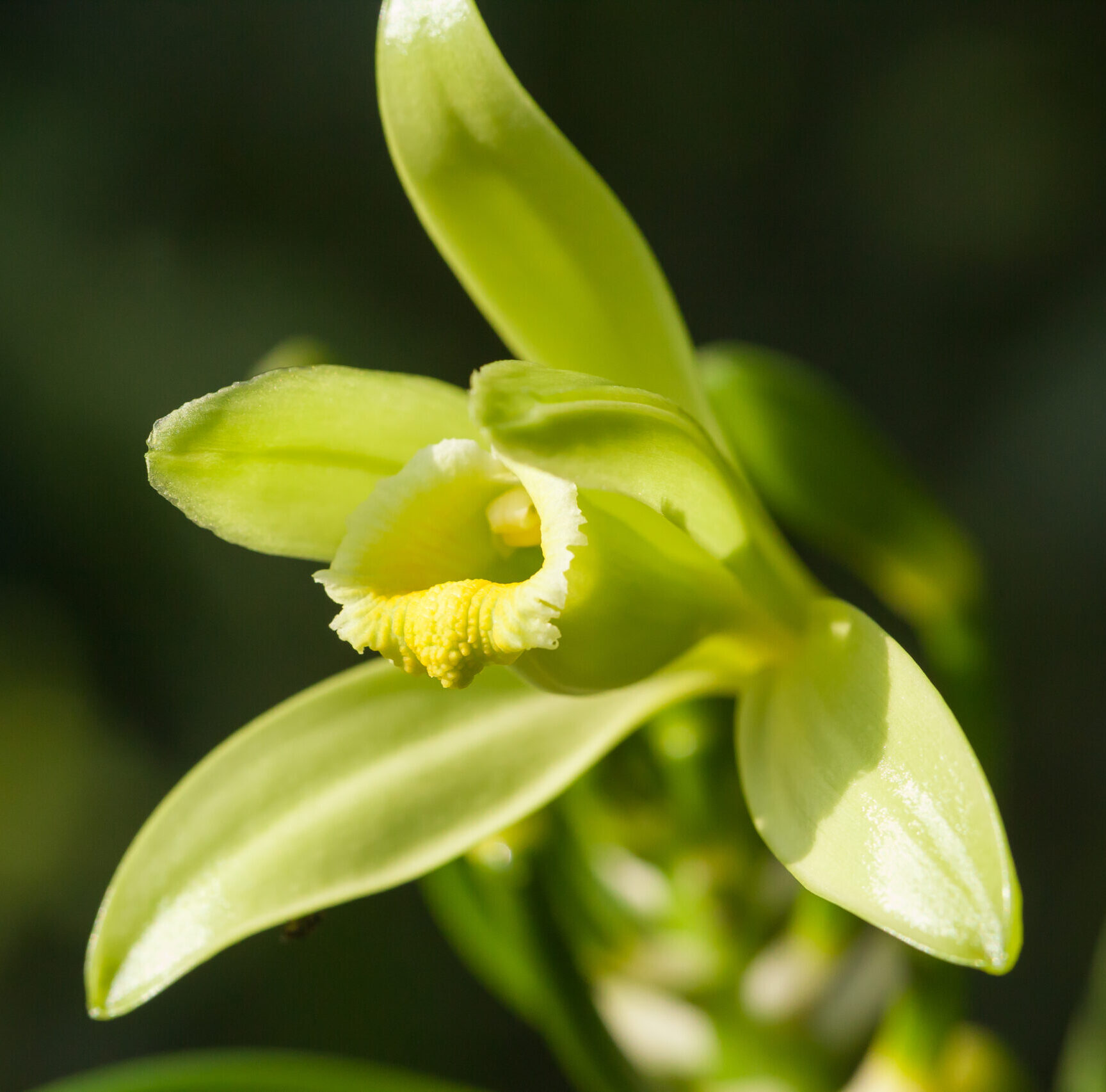
Dorsal Sepal
Located at the top of the flower, the dorsal sepal is greenish-yellow in color.
Its function is to protect the flower bud and support the overall structure of the flower.
Petals
Arranged symmetrically on both sides of the flower.
Their main role is to attract pollinators. They resemble the sepals in shape but are softer in texture.
但質地較柔軟。
Column (Gynostemium)
The most distinctive structure of the vanilla flower, located at the center.
It serves as the primary landing platform for pollinators or for manual pollination.
包含 花藥Inside, it often features hairs or folds that guide the pollination process. 柱頭(雌蕊)。
Labellum (Lip)
Located at the bottom of the flower, it is specialized into a groove-like shape.
It serves as the primary landing platform for pollinators or for manual pollination.
Inside, it often features hairs or folds that guide the pollination process.
Lateral Sepals
Arranged alternately with the petals, located beside them.
Together with the petals, they form the external shape of the flower.
From Farm to Table We chose the slowest, yet most grounded path.
How to Pollinate Vanilla Flowers
Step 1. Locate the Flower Structures
Gently lift the labellum (lip) — the specialized petal located at the bottom of the flower.
You will see the column, with the anther (male) on the top and the stigma (female) underneath. Between them is a thin membrane called the rostellum.
Step 2. Remove the Membrane
Using a bamboo stick or toothpick, carefully lift and remove the rostellum to allow contact between the anther and stigma.
Step 3. Pollination
Press the pollen from the anther onto the stigma.
Gently close the labellum to protect the pollinated area.
Step 4. After Pollination
If pollination is successful, the flower will not wither. The ovary will slowly enlarge and, after about 8–9 months, mature into a vanilla pod.
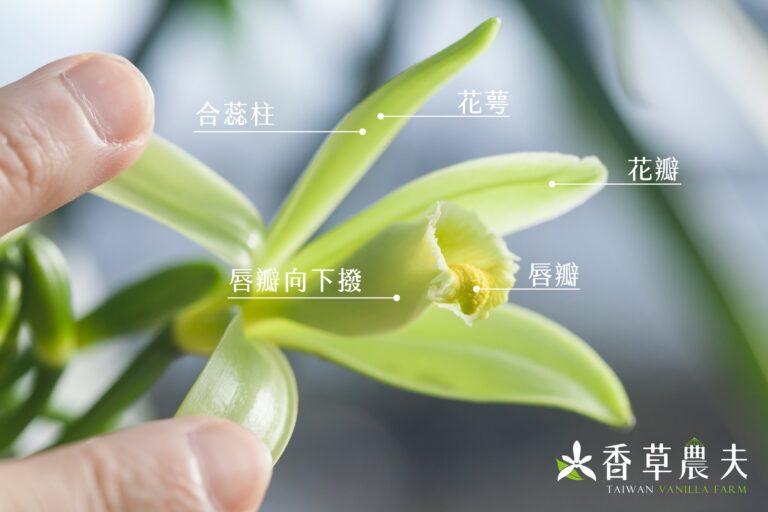
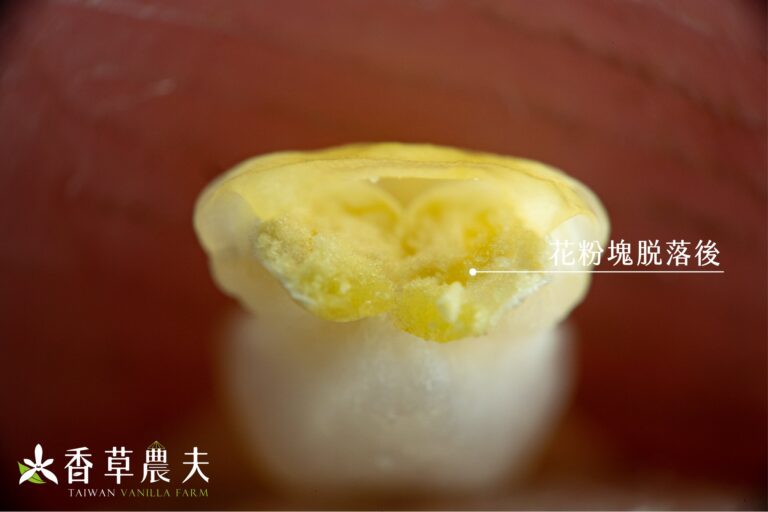
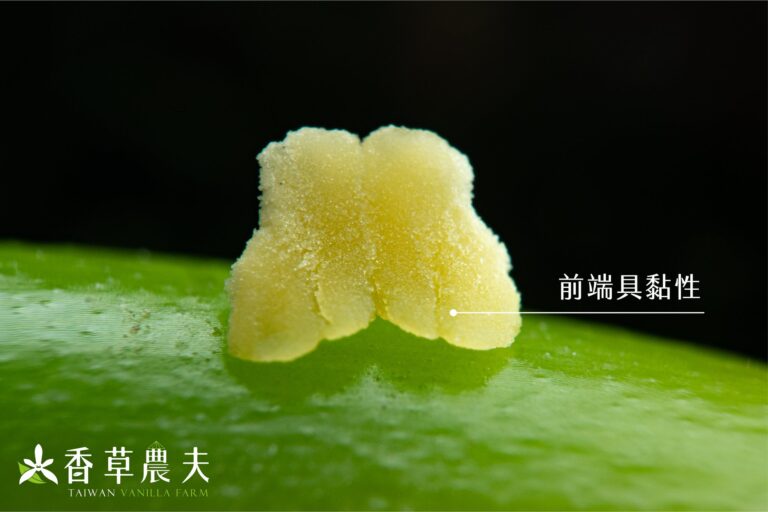
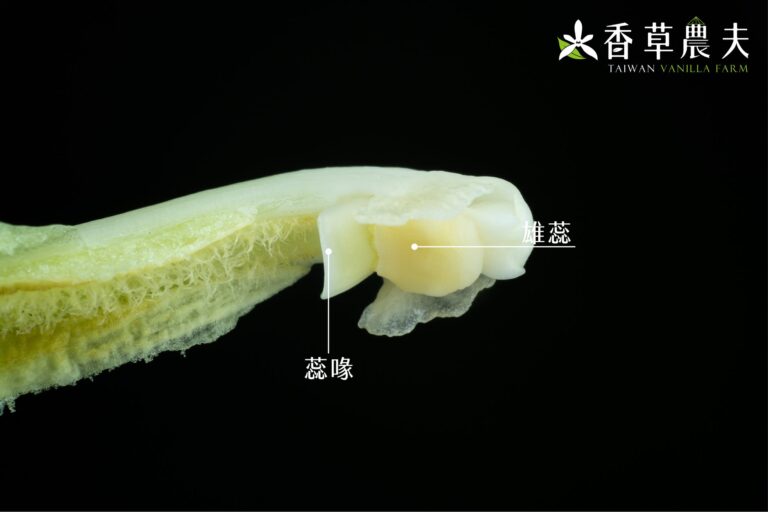
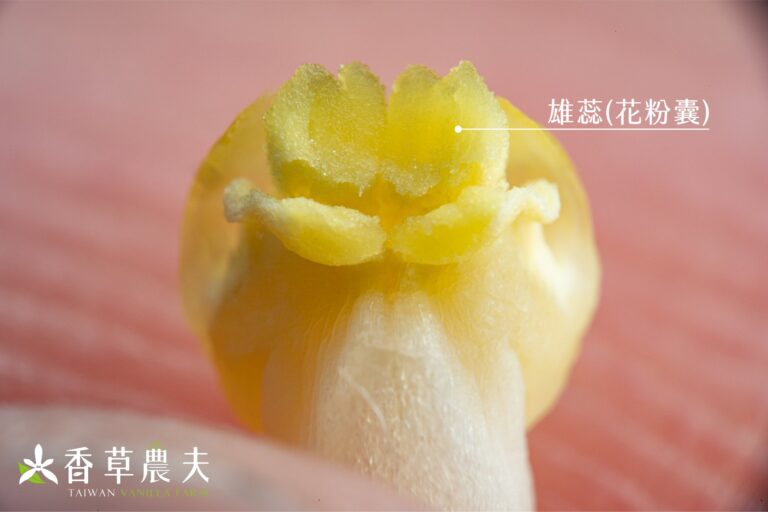
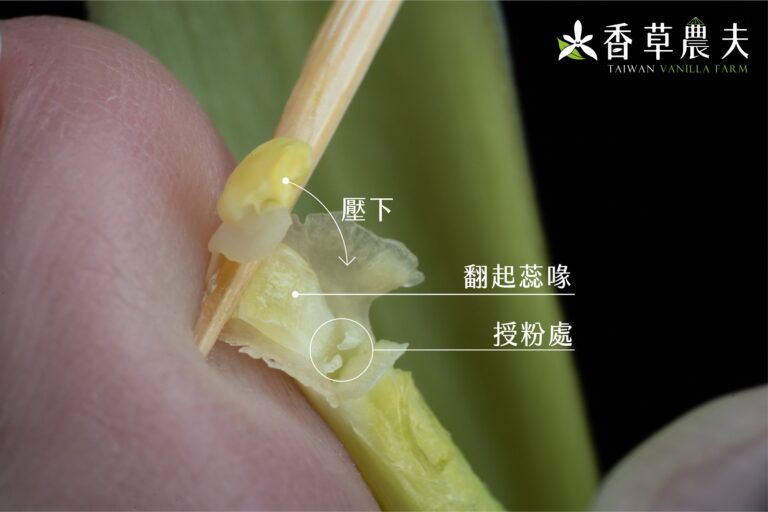
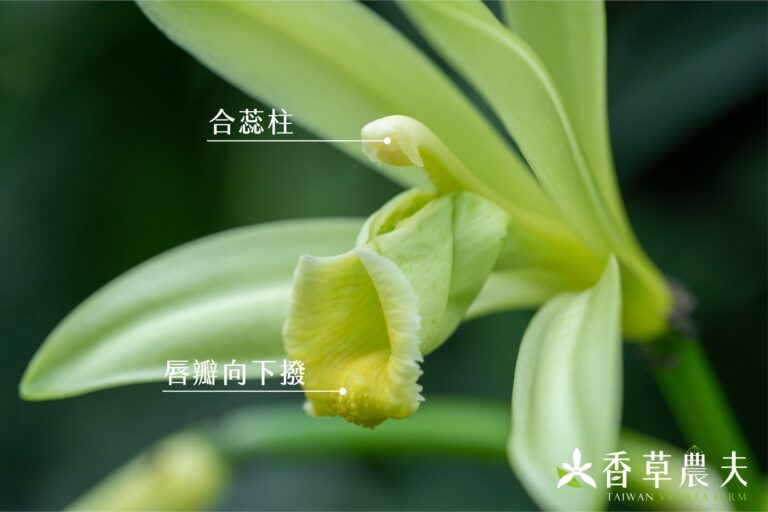
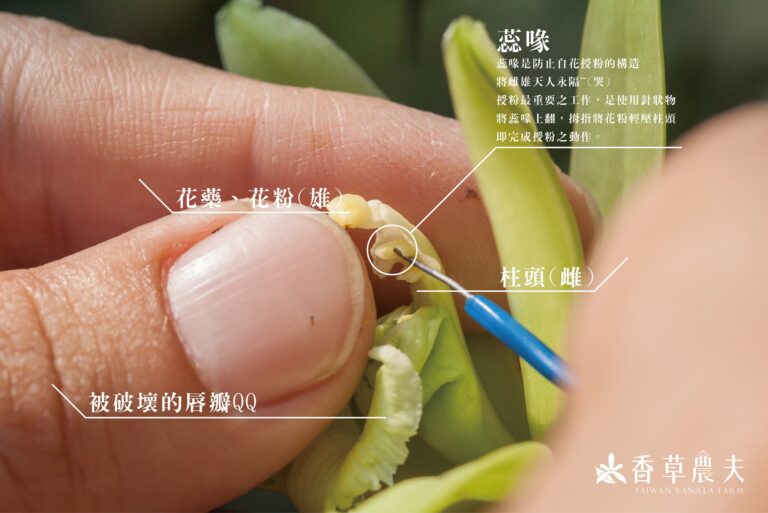
How We Work
Planting Q&A
Growing Environment
Vanilla plants have a high water content, with only 10% solid matter. Leaves contain 92% water, and stems contain 89%. This makes them highly susceptible to drought. Cultivation requires an environment with abundant water supply, calm winds, and high humidity. Barriers should be erected to maintain air humidity at 70–80%. Covering the roots with materials like wood chips, dry leaves, or straw (disinfected) helps reduce water evaporation, keep the soil moist, and ensure adequate water supply to prevent plant dehydration.Spray irrigation is used to increase air humidity and maintain soil moisture at 25–30%. The optimal soil pH is around 6.0–6.5 for normal growth.
Vanilla is a temperate plant that thrives in warm conditions. The average daily temperature should be 21–29°C, with the optimal range being 25–29°C. During Taiwan’s winter cold snaps, prolonged low temperatures may cause growth retardation or frost damage to tender shoots.
The differentiation of vanilla flower buds occurs in winter, requiring a period of low temperatures. The suitable average temperature is around 15.5–27.8°C. With the arrival of spring, flower buds will emerge from the nodes.
Vanilla is a perennial herbaceous vine from the orchid family, preferring to grow in partially shaded environments. Direct sunlight or excessive light can scorch tender shoots, causing leaf discoloration, black spots, wilting, and withering. Before planting, install trellises and use 50% shade nets during the growth period to promote healthy plant development.
Vanilla is a perennial herbaceous vine from the orchid family, preferring to grow in partially shaded environments. Direct sunlight or excessive light can scorch tender shoots, causing leaf discoloration, black spots, wilting, and withering. Before planting, install trellises and use 50% shade nets during the growth period to promote healthy plant development.
QA
Yes, but check if the soil is too compact. Add coconut coir or other aerating materials to loosen it. You can also use peat soil to improve soil permeability, enhance drainage, and support the growth of aerial roots.
Once the seedlings grow over 30 cm, you can repot them using potting soil or peat soil purchased from gardening stores.
Typically every 3–5 days, but adjust based on the growing environment and pot size. Keep the soil slightly moist.
Vanilla seedlings bloom after three years. Ensure adequate light in the growing environment, as insufficient light can hinder blooming. After pollination, the flowers develop into vanilla beans, which can be harvested once matured.
Let the plants acclimate to their environment first; watering is sufficient. Over-fertilizing during the seedling stage can cause fertilizer burns, stunted growth, or plant death. Fertilize only after the plant grows to about 1 meter.
Use balanced fertilizer (N:P:K = 20:20:20). For seedlings under 1 meter, dilute 3000 times; for plants over 1 meter during the growth phase, dilute 1000–1500 times. Fertilize every 15 days.
You can buy any orchid-specific fertilizer from flower shops!
Yes, it is recommended to select seedlings that have grown for over a year for cutting, as they are stronger. Cuttings from plants under a year old will produce thinner new shoots.
It is recommended to use durable and sturdy materials such as cement columns, plastic pipes, or thick bamboo poles with crossbars. Vanilla requires at least three years of cultivation, and its vines are heavy, so these supports are necessary.
Once vanilla vines reach the desired height, let the branches grow downward. When they touch the soil, bury two nodes in the soil; they will continue to grow upward afterward.
In the first year, vanilla grows about 2 meters, 4 meters in the second year, and 8 meters in the third year. Afterward, it maintains a growth length of 8 meters.
The simplest method is to sun-dry them for 4–5 hours daily under direct sunlight.
We offer wholesale options for 2–3-year-old mother plant cuttings, which are robust and grow quickly. The current prices are: 100 pots ($180/pot), 200 pots ($150/pot), and 500 pots ($140/pot).
Farm tours require a reservation at least 7 days in advance and a minimum of 4 participants. For details, please message the "Vanilla Knight" Facebook page.
Approximately 300–400 plants
Approximately 1–1.5 meters
Video
厭世甜點店
台灣香草冠軍,一根破千元的夢幻品種!香草莢超狂用法,竟然可以拿來…?
香草莢紀錄片
台灣香草莢的一生「波本香草莢」「天香香草莢」
台灣第一等
香草花最佳助孕手
